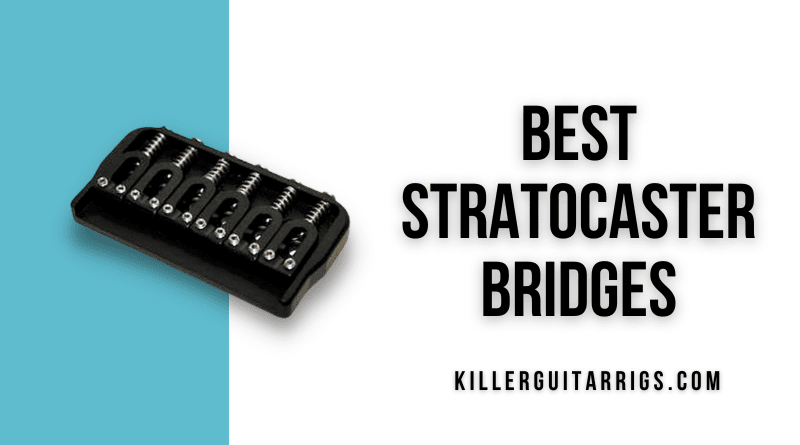It’s fairly common to replace your original guitar bridge in order to enhance tone and stability. Stratocasters are no exception and there are plenty of bridge models out there to upgrade your precious guitars.
Although all bridges do the same basic job of holding your strings in place, they vary greatly beyond that. Whether you want a truly stable bridge to play jazz or you prefer to play rock or metal and use the whammy bar to the max via a floating bridge, there is something out there for you.
In this article, we’ll give you some of the best options for replacing your Strat’s bridge, as well as some tips on what to look for. Keep reading.
Read more about our review process.
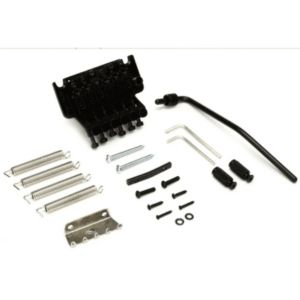
Floyd Rose FRTS2000 Special
Features: Locking nut, zinc alloy saddles/block, Includes all hardware
Benefits: Turn key package, Fantastic tuning stability, Lightweight
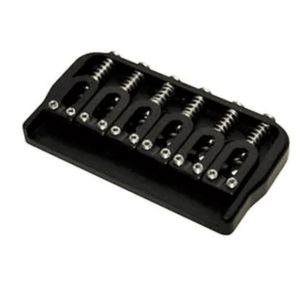
Hipshot 6-String US Fixed Guitar Bridge
Features: Stainless steel saddles, Solid brass base plate, Ambidextrous installation
Benefits: Suitable for left/right handed Strats, Smooth feel, Excellent corrosion resistance
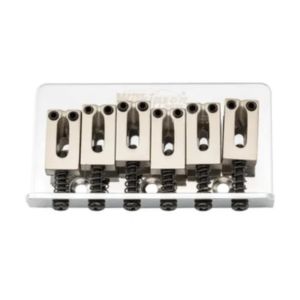
Wilkinson Hardtail Saddle
Features: (2-1/16 inch) String Spacing, Steel construction, 3 Screw securing
Benefits: Easy installation, Extremely durable, Highly adjustable saddles
Contents
Our Top 5
The Hipshot 6-String US Fixed Guitar Bridge is our Top Choice for this list. This bridge is a great match for the modern guitarist. It fits in a variety of guitars and provides great stability, tuning, and sustain, with a simple installation process.
The Wilkinson 52.5mm (2-1/16 inch) String Spacing Hardtail Fixed Bridge is our Budget Choice. This bridge is an affordable and reliable replacement option for budget guitars, as it’s sure to provide better stability and sustain.
Last but certainly not least, the Floyd Rose FRTS2000 Special Tremolo System is our Editor’s Choice. It ships with all necessary installation hardware and provides superior stability and tuning for folks who make extensive use of the whammy bar. A great option for dedicated professional guitarists.
Individual Reviews
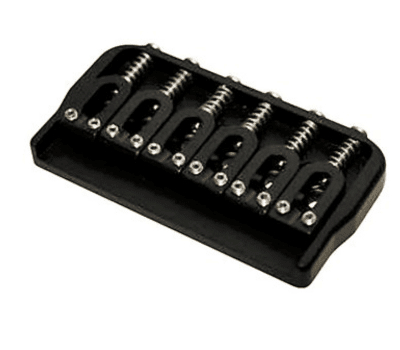
Hipshot 6-String US Fixed Guitar Bridge
A fantastic choice for an upgrade on tone and stability.
Hipshot is one of the most well-regarded companies when it comes to guitar bridges. This particular model offers the timeless, classic style and all the quality that savvy guitarists have come to associate with this company. Simply said, one of the best fixed bridges on the market today.
The Hipshot 6-String US Fixed Guitar Bridge is as good and effective as it looks. It can also fit in a variety of guitars. We installed it in our American Standard Fender Stratocaster to conduct our tests, while plugged into our trusty Twin Reverb amp.
Installation is a rather simple endeavor if you have some experience setting up guitars and replacing parts yourself. We’ve certainly done our fair share of that over the years, so installing this bridge was no problem. Naturally, if you have never done this before, it’s best visit a luthier or have a more experienced friend help you out.
Once installed, we started playing in a variety of styles and with the help of different effects really tested out this Hipshot bridge. The first thing we loved was its ergonomics. Featuring a hand-polished finish, this bridge felt smooth and comfortable under our palm.
The second thing we loved is how stable it felt. Naturally, a fixed bridge offers even greater stability. During our tests, we felt that both the intonation and tuning were on point, and we could even hit the strings hard without worries. This was in part thanks to the sidewalls, which lock our saddles in place, allowing for forceful playing.
The fact that the saddles are made of stainless steel is a great feature on this bridge and helped us achieve great sustain and tonality. We also loved the string-through-body design, which gave us stellar down pressure on the bridge and saddles.
We also loved the improvement in sustain that this Hipshot bridge provides. This was especially true when we played some overdriven and distorted lines with a bit of reverb and delay. Our tone had a bit more of a singing quality to it, always with good intonation as well.
If you’re left-handed, fear not. The Hipshot 6-String US Fixed Guitar Bridge is ambidextrous.
In short, a fantastic option for folks looking for a stable bridge with great stability and sustain.
Verdict: The Hipshot 6-String US Fixed Guitar Bridge fits both right- and left-handed guitars and offers fantastic intonation and sustain. Besides, it gives the player great ergonomics and stability even for those who like to attack the strings hard.
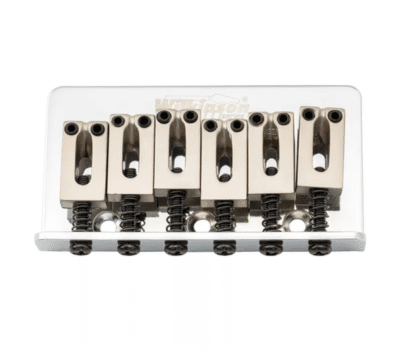
Wilkinson 52.5mm (2-1/16 inch) String Spacing Hardtail Fixed Bridge
A solid and affordable choice for better stability and tuning.
This is a good option for folks that are short on cash but want to upgrade their bridge. They are especially good for those upgrading from a Squier Strat or similar instrument and are looking to get a bit more stability and greater sustain.
The Wilkinson 52.5mm (2-1/16 inch) String Spacing Hardtail Fixed Bridge can be employed for string-through bridge designs and string-through body as well, giving the user a bit of flexibility. The manufacturer recommends this bridge as a replacement for budget guitars, in order to elevate the overall performance of the instrument.
For this test, we brought out our old Squier Strat in order to replace the original bridge with this Wilkinson and then compare. Installation was relatively simple, although if you are a beginner, seek out the help of a luthier or more experienced professional. This bridge ships with the necessary mounting accessories. These include three mounting screw holes and the spacing on each mounting is 21.5 mm.
Each saddle features a width of 10.5 mm and provides for a 52.5 mm (2-1/16 inch) string spacing. Once installed, we alternated our trusty Ibanez Tube Screamer with our Electro Harmonix Big Muff Pi to evaluate if the sustain had improved. Much to our delight, we found this Wilkinson bridge provided us not only with greater sustain but also a fatter middle range. The overall sound got a bit smoother as well.
The other noticeable improvement over the Squier factory bridge is that the Wilkinson bridge was more stable. Part of the reason we don’t use that Squier guitar much anymore is that it consistently goes out of tune. The Wilkinson bridge was a much-needed improvement, as it allowed us to get through a few riffs and solos without having to retune every few minutes.
This bridge also felt a lot more comfortable to the touch, particularly when we palm-muted some parts. Here too, not only was the tuning better, but the intonation also seemed to improve.
Regarding stability, if you have a Squier or similar guitar with a floating bridge, then the Wilkinson is likely to provide you with even better tuning. We set it up to sit tightly against wood, in order to improve the overall performance of our Squier, and we surely accomplished that.
In short, a very affordable option for folks who are struggling with tuning and sustain issues on a budget instrument. Guitars like Squier Strats and similars are very likely to improve in tone, sustain, and stability by a mile when this bridge is used to replace the factory original.
Verdict: The Wilkinson 52.5mm (2-1/16 inch) String Spacing Hardtail Fixed Bridge is a smart choice for replacing the original bridge on a budget instrument. Besides being the most stable option for affordable bridges (fixed), this model can also improve the sustain and overall tone of your beginner instrument.
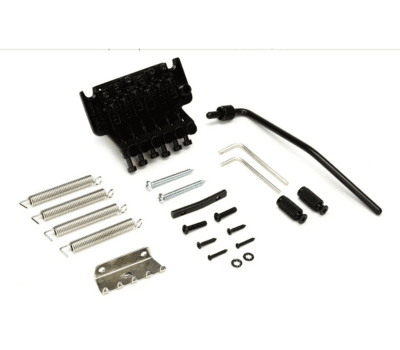
Floyd Rose FRTS2000 Special Tremolo System
A classic and ever popular floating bridge for pros.
Since its invention in 1976, the Floyd Rose bridge has become a staple of guitar playing among many, particularly those that play rock and those with a taste for virtuoso playing. Legends like Eddie Van Halen, Joe Satriani, Steve Vai, and Alex Lifeson helped popularize this floating bridge and it remains a relatively common choice for many guitarists.
The Floyd Rose FRTS2000 Special Tremolo System ships all necessary installation hardware, including mounting studs, springs, and claw. You do need to purchase a locking nut separately to go with this bridge.
We were eager to try out this bridge and installed it in our American Standard Stratocaster, while also installing an R3-sized locking nut with its respective clamps.
In reality, you don’t necessarily need to install a new nut, but we wanted to have the full-on Floyd Rose experience, with its two locking points. Installation, although not overtly complex, is a bit more involved than with a regular bridge. So make sure you get help if need be.
Once we installed the Floyd Rose FRTS2000 system, we were ready to put it through its paces. For that, we plugged right into our Marshall combo amp and used our Super Badass MXR distortion pedal. At first, we played through several riffs and licks without engaging the bridge itself. Our tuning and intonation remained stable through all of our tests, so we were ready to take it up a notch.
We then started bending gradually, as well as pulling lightly, going for subtlety on some held power chords, and our tuning held nicely throughout this first batch of tests. Then we gradually increased how far we took the whammy bar (in both directions) and ended up doing dive bombs aggressively.
After a while of playing through our attempted guitar pyrotechnics, we checked the tuning once again and saw that our Strat was still in tune. In other words, the Floyd Rose FRTS2000 offers superior tuning stability for folks who like to abuse the whammy bar.
Throughout our tests, we felt comfortable with this floating bridge, as it provided an ergonomic playing experience. With 0.42-inch string-to-string spacing and 2.91-inch center-to-center post spacing, we felt at home with the Floyd Rose FRTS2000.
In short, a fantastic choice for a floating bridge made for professionals who need superior tuning and stability at all times, regardless of how aggressively they use the whammy bar.
Verdict: The Floyd Rose FRTS2000 Special Tremolo System gives you superior stability and allows you to stay nicely in tune even when going for some wild dive bombs. This floating bridge is a fantastic choice for rock players and other virtuosic types of musicians who delve into guitar pyrotechnics and other distortion-induced genres.
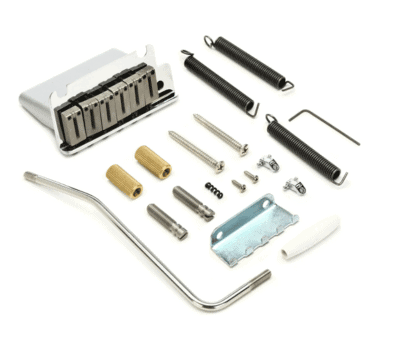
Fender American Series Strat Tremolo Bridge
A classic bridge for the modern player.
This bridge is a good choice for folks that own American and American Standard series Stratocasters. Fender states that this bridge will fit guitars manufactured between 1986 and 2007. It being a fixed bridge, we expected it to have superior stability. We put it to the test with our 1997 American Standard Strat.
The Fender American Series Strat Tremolo Bridge ships with six powder-coated steel block saddles with off-center intonation screws, mounting hardware, and adjustment wrenches. The package also comes with a tremolo arm with a screw-in design on a white tip.
The installation of this bridge was a straightforward process and once we set it up, we plugged our 1997 American Standard Strat into our Roland JC-120 to test it out.
The first thing we liked about this bridge is how it felt to the touch of our palm. The still block saddles are really smooth and made of powder-coated steel with a beautiful chrome finish. We felt comfortable performing a number of techniques, including palm muting.
We then played through a series of our pedals, including some distortion, overdrive, and fuzz units. The sustain of our Strat was improved a bit. This was noticeable mostly on distorted parts, especially single lines that had a bit of reverb added to them.
The Fender American Series Strat Tremolo Bridge also did well in the stability department. Our tuning remained stable throughout our tests, even with constant full bends all over the fretboard and some intense dives on the tremolo arm.
While testing it with clean sounds, we felt this bridge improved the overall performance of our Strat. This is particularly true when it comes to tuning, as we were able to play for long stretches without having to face any major tuning issues.
This fixed bridge features a string spacing of 0.5″, which is basically standard and feels familiar to anyone who plays Strats. Overall, the Fender American Series Strat Tremolo Bridge gets the job done well and delivers sustain and stability. That said, it only covers mostly American and American Standard Stratocasters made from 1986 to 2007, which is a bit limiting.
Verdict: The Fender American Series Strat Tremolo Bridge ships with everything you need for a simple installation process. This bridge is a good choice for American Standard Strats from 1986 to 2007, and offers great stability and improved sustain. The package comes with a tremolo arm on a screw-in design on a white tip.
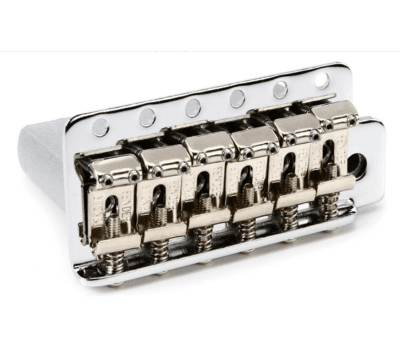
Fender Stratocaster Bridge Assembly Vintage-Style
A classic style fixed bridge at a great price.
This bridge provides players with a vintage design, feel and looks, but without having to break the bank on a vintage guitar. Additionally, it offers the stability we’ve come to expect with modern guitar bridges, and comes from Fender, the original Strat maker.
The Fender Stratocaster Bridge Assembly Vintage-Style offers players the ability to swap their current bridge with a vintage-type bridge that offers the stability that modern players expect.
With a plated, die-cast construction and finish, this bridge was made specifically for models that can house a vintage-style bridge. It will fit several models of guitars, including Deluxe Fat Strats, Deluxe Player Strats, Double Fat Strats, Deluxe Powerhouse Strats, and others.
Our installation of the Fender Stratocaster Bridge Assembly Vintage-Style was a relatively simple endeavor, and it should be that way for anyone who has successfully conducted a bridge replacement in the past. In any case, don’t shy away from using a luthier or guitar specialist if you have any doubts about how to install it.
Once in place, we plugged our Strat into our Twin Reverb to run some tests. We played through a series of motives and accompaniment patterns in order to simulate real-life playing experiences. During our tests, we felt this bridge provided good stability for its price. That said, we didn’t see an improvement in the tone or sustain of our instrument, not even when playing through heavily distorted solos and power chords.
As far as comfort, we felt right at home with this bridge, as we’ve owned some other Strats with vintage-style bridges in the past. Our right hand felt the familiar touch of classic-style stamped steel saddles, so there were no surprises there. Naturally, we played more conservative and traditional parts in order to match this bridge style, with your typical average guitarist stuff: chords, blues licks, some finger picking, etc.
This bridge features a 2-3/16″ mounting spacing and can take any standard 10-32-inch tremolo arm. Since it’s a vintage style bridge, we played according to what most folks that see out this bridge would. In other words, no dive bombs or pyrotechnics. Just good ol’ rock and blues, with a bit of country and even a jazz lick or two.
In short, a good and affordable vintage-style bridge for a player who prefers that classic feeling. Guitarists looking for a modern feel, or those that seek to improve their sustain, may wanna look elsewhere.
Verdict: The Fender Stratocaster Bridge Assembly Vintage-Style offers players the ability to swap their current bridge with a vintage-type bridge that offers the stability that modern players expect.
How to Choose the Right Bridge for You
Guitar bridges come in many variations, for all types of players and playing preferences. At its core, all types of guitar bridges accomplish the mission of holding one end of the strings in place and transmitting the vibration of said strings.
Electric guitar bridges can be divided into two kinds: fixed and floating. As usual, each has its own advantages. The differences between a fixed bridge and a floating bridge have a big effect on your choice of electric guitar. Besides looking different and having the potential to severely impact what your guitar looks like, they also determine aspects like types of sounds you can make, tuning stability, and maintenance.
Fixed Bridge
Fixed bridges are screwed into the body of your guitar and keep the strings resting in place by the use of saddles. They are also commonly referred to as hardtail bridges.
Fixed bridges come in a more straightforward design than floating bridges and are commonplace on electric guitars. Although Strats usually tend to feature floating bridges, some models do come with fixed bridges in order to satisfy demand and you can also choose to swap your tremolo bridge for a fixed model.
For keeping the string ball ends in place, fixed bridges feature narrow holes that allow only for the string to pass through. These are found either at the bridge tailpiece itself or on the back of the instrument’s body. Once in place, the string then goes over the saddle, along the fretboard, and all the way up to the tuning pegs on the headstock.
One of the most famous fixed bridge types is found on Gibson’s Les Paul guitars. These instruments feature the Tune-O-Matic bridge, which many players prefer because they provide great stability and legendary sustain. Although not commonly found on Strats, you could have a luthier outfit you with one if that’s your choice.
One of the advantages that often go unmentioned about fixed bridges is how simple it is to restring guitars that feature them. This is particularly useful for beginners, as it will likely make their lives easier when trying to change a set of strings and tune them up.
Intonation fixes are also easier to carry out on fixed bridges, by adjusting the saddle position with a simple screwdriver. In short, fixed bridges are easier to deal with and tend to provide superior stability.
On the other hand, some fixed bridges are also prone to string slippage, although this can be dealt with effectively by employing quality tuners and a quality nut. Locking tuners also help to keep the strings tightly in place at the headstock and are a relatively common feature on some more expensive instruments.
Floating Bridge
Although often preferred by modern players that engage in fast playing and guitar pyrotechnics, floating bridges have been around since the 1920s. The Bigsby model was the first commercially successful vibrato system, and still is sought after today by players with a taste for vintage gear.
Later, the block tremolo bridge had a big influence on floating bridge designs, as it paved the way for curbing extreme detuning caused by the tremolo movement.
With time, modern double-locking tremolos were developed and became popular in the late ’70s and ’80s. The Floyd Rose system became sort of a paradigm for floating bridges, and its popularity soared among rock and metal players with high technical prowess.
Guitar legends like Eddie Van Halen, Joe Satriani, and Steve Vai all employed Floyd Rose tremolo systems and gave us some of the most beautifully adventurous music, starting in the late ’70s and all the way to today.
The popularity of double-locking systems rose in part due to the fact that guitarists could use vibrato far more aggressively with these types of bridges. From divebombs to sharp pitch flutters, these bridges allowed you to experiment while keeping the strings locked in place to minimize tuning slippage.
However, there are also some disadvantages to floating bridges. First, in order to really go wild on the tremolo, you need to spend more to get a quality floating bridge that’s stable.
Additionally, floating bridges don’t always get along with palm-muting. Depending on how they’re set up, any amount of pressure on them will affect pitch. Naturally, you could set the bridge flush against the body, but this limits your tremolo, only allowing it to go down in pitch but not up. In other words, pick your poison.
Another issue with floating bridges is that changing strings isn’t easy, particularly for beginners. The good news is that with time and patience, all can be conquered. That said, floating bridges are not a wise choice for most beginners.
Final Thoughts
Replacing your Stratocaster bridge will likely result in an upgraded guitar. There are several options in the market, so it’s crucial for you to narrow your choices. Naturally, the best way to do this is to try different guitars with different bridges.
By now we know that the first factor to decide is whether you want a fixed or tremolo bridge. So make sure you have played at least a few of those and know what they feel like, and their pros and cons before you make your choice.
To recap our top picks for this article, we got the Hipshot 6-String US Fixed Guitar Bridge is our Top Choice. This bridge is a fantastic choice for modern players seeking to upgrade their tone and stability. It fits in a variety of guitars and provides great stability, tuning, and sustain, with a straightforward installation process.
The Wilkinson 52.5mm (2-1/16 inch) String Spacing Hardtail Fixed Bridge is our Budget Choice. This bridge is an affordable and sound replacement option for budget guitars, ideal for those looking for better stability and sustain.
Finally, the Floyd Rose FRTS2000 Special Tremolo System is our Editor’s Choice. It comes with all necessary installation hardware and offers great stability and tuning for discerning musicians that make extensive use of the whammy bar. A great option for dedicated professional guitarists.

